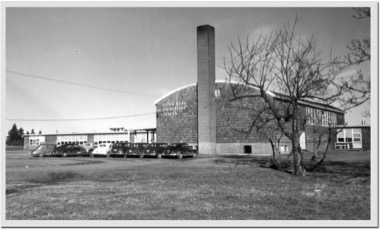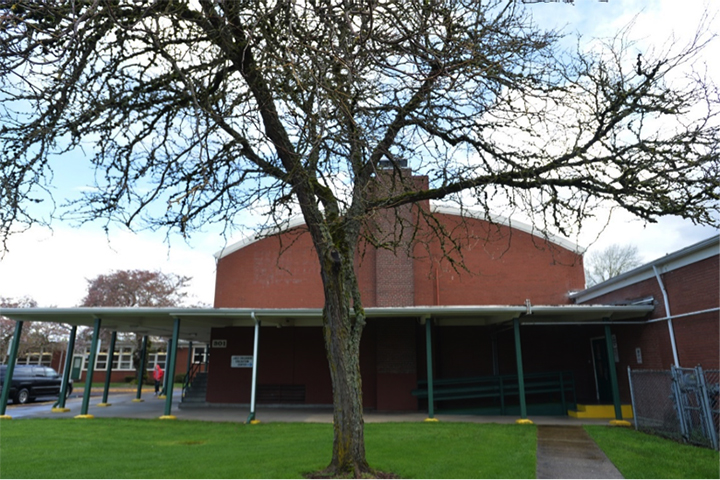First photo above: The 72-year-old school has water leaks, a damaged gym floor, old windows, a poor technology infrastructure and bathrooms that weren’t designed for older students. Second photo: Nearly 40 people participated in a symposium on Nov. 1 to imagine the future of the Lieser campus.
School built in 1940s
Lieser Campus is home to nontraditional options in education for students in kindergarten through 12th grade. The programs at this school provide a personalized approach to education for students who want to work in a flexible, independent learning environment led by highly qualified teachers.
The building that houses the Lieser Campus was constructed in the early 1940s to accommodate the many families who moved to the McLoughlin Heights, Bagley Downs and Burton Homes areas during World War II to work in the shipyards.
Lieser Elementary opened in 1944 and served students until 1992. Since then, it has been used for early childhood education programs; Vancouver Home Connection, a classroom-based parent-partnership program; Virtual Learning Academy, an online and blended-learning program; Open Doors, a GED preparation and testing program offered through Educational Service District 112; and early childhood screenings for developmental delays.
Today, however, the aging Lieser facility no longer adequately supports 21st-century educational requirements. There are many challenges:
- Age: At 72 years of age, the building has surpassed its useful life. Water leaks are evident throughout the facility and have damaged walls. The windows are in disrepair, and the heating and ventilation system is antiquated.
- Lack of technology infrastructure: Because the building predates modern technology, it is not equipped to provide the infrastructure for today’s devices.
- Restrooms: Originally designed for elementary students, the current restrooms do not meet the needs of the Lieser Campus’ older students and staff members.
- Space constraints: Growing enrollment and new Lieser programs have resulted in an influx of students. Office space is limited as a result. Some teachers must use the faculty lounge instead. There is little room for students to work independently or in groups, nor is there room for the school to provide supports such as tutoring, counseling, career advising and hands-on learning.
Despite these challenges, the school has found ways to excel. For example, Vancouver Home Connection received the Washington State Association for Supervision and Curriculum Development’s 2012 Supported Students Award. The award is intended to recognize educator(s) who contribute to providing a school where students have access to personalized learning and are supported by qualified, caring adults.
“Our job is to serve students in the best way possible,” said Principal Deanna Hogan.
However, she acknowledged that Lieser “students deserve 21st-century spaces for 21st-century educations in order to become future-ready graduates.”
Vancouver Public Schools has a plan to address Lieser’s facility-related challenges. On Nov. 1, the district sought input from staff members, parents and students, who engaged in a symposium to discuss Lieser’s future. As a result of their feedback, planning teams worked to create a vision for Lieser’s future.
Symposium
A Nov. 1 symposium involved nearly 40 people in a discussion about future learning needs and interior and exterior design considerations. Participants included Principal Deanna Hogan, Associate Principal Anita Chase, several staff members, students Emmalei Reynolds and Daizy Cervantes, parents Elizabeth Reynolds and Kurt Prastka, school board Vice President Michelle Giovannozzi and many more valued stakeholders.
Their feedback revealed a few key themes for consideration as plans progress for Lieser’s future:
- Personalized learning: meeting students’ individual learning needs and celebrating different learning styles
- Lieser identity: creating a greater school identity founded on inclusiveness, unity, safety and pride
- Flexibility in teaching and learning: providing comfortable, flexible spaces for students ages 5 to 21 to learn and fully engage in their studies in partnership with teachers, parents and the greater community
- Technology: accessing technology for enhanced learning and collaboration
- Meeting needs: helping to fulfill all needs in school and beyond, including basic needs assistance, health, mental health, mentoring, career exploration opportunities and more

Above: Lieser Elementary circa 1942

Above: Today, the school looks much the same as it did in the 1940s, and the building is showing its age.


